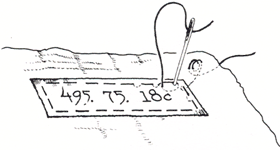Applying Accession Numbers to Textiles – Canadian Conservation Institute (CCI) Notes 13/8
(PDF Version, 377 KB)
CCI Note 13/8 is part of CCI Notes Series 13 (Textiles and Fibres)
Introduction
Accession numbers provide a link between objects and the documents related to them, and identify objects as part of a collection. When applying accession numbers to a textile or costume, apply the numbers in the same location as much as possible (e.g. apply accession numbers to centre back of dresses). The consistent placement of accession numbers will reduce unnecessary handling of the object. All elements of an object, if they are detachable, should be labeled with an accession number.
Accession Labels
The "Cotton and Krylon" Method
Of the many ways to apply accession numbers to textiles, the "Cotton and Krylon" method is one that has found much favour in museums. The method involves spraying a cotton fabric label with Krylon Nº 41303 Crystal Clear (acrylic resin), typing or printing on the accession number, respraying the label, and stitching it onto the textile. Such labels are quick, easy to produce, durable, legible, and unlikely to harm the textile onto which they are sewn.
Procedure
The recommended material for labels is a densely woven, white cotton fabric (e.g. sheeting material). The procedure is detailed below. Note that it is possible to carry out Step 3 with a typewriter or a laser jet printer. However, if using a printer, check with the manufacturer for material compatibility.
- Cut the fabric to the size of a sheet of typing paper (so that it can be inserted into a typewriter) and iron it.
- Spray the fabric thoroughly and evenly with Krylon and allow it to dry completely (about 15 minutes). Be sure the area in which you are working is well-ventilated, or work outdoors.
- Type on the accession numbers, leaving about 1 cm between each different number.
or
Using double-sided tape, attach Krylon-coated fabric to the top and bottom edge of a piece of paper. Manually feed the fabric/paper through the printer. It is best to print a full page of accession numbers at one time because the fabric/paper should not be fed through the printer more than once. Feed only one sheet of fabric/paper through the printer at any one time to prevent the heat generated by the printer from disrupting the path of the paper. Laser jet printers that have a straight paper path are ideal for this purpose. - Cut off the typed section, respray it with Krylon (in a well-ventilated area), and allow the Krylon to dry.
- Cut around each accession number, leaving a 5 mm margin on all sides.
- Pin the label to the textile.
- With a fine sewing needle and white cotton or cotton/polyester blend sewing thread, hand-stitch the label to the textile as shown in Figure 1. Begin and end with a few back stitches — in the label, not in the textile — instead of making knots in the thread. Do not attempt to stitch through fragile fabrics such as shattering silk.

WARNING: Krylon is soluble in dry-cleaning fluids, and when the Krylon coating has been dissolved, these fluids may also remove the number that has been typed/printed on the fabric. Even if the number remains, the label will no longer have the protection of a resin coating and may have limited durability. For example, the number may not withstand washing.
Waterproof, lightproof pens
A waterproof, lightproof pen is also an option for making accession labels. Ensure that the pen used is waterproof and does not bleed. The pen can either be applied to Krylon-coated fabric or to white cotton tape. Clearly print the numbers on the label and hand-stitch as described above. If cotton tape is used, fold the cut ends of the tape under before stitching.
Auxiliary accession numbers
Providing an auxiliary accession number is simple to do and can significantly reduce unnecessary handling. For example, paper or Tyvek tags suspended from the hangers used to store some costumes are easier to locate than an accession number stitched inside the costume. Accession numbers can also be applied to visible locations on storage mounts. These auxiliary accession numbers should also be made using wetfast and lightfast materials.
Suppliers
Note: The following information is provided only to assist the reader. Inclusion of a company in this list does not in any way imply endorsement by the Canadian Conservation Institute.
Cotton sheeting, cotton tape, cotton or cotton/polyester blend sewing thread, needles:
fabric stores
Krylon Nº 41303 Crystal Clear (aerosol cans):
art supply stores
Double-sided tape, waterproof, lightfast pen (e.g. Staedtler Pigment Liner, drawing and writing pen):
stationery stores, art supply stores
Tyvek:
Bibliography
-
Dudley, D.H., I.B. Wilkinson, et al. Museum Registration Methods, 3rd revised edition Washington, DC: American Association of Museums, .
-
Grattan, D.W. Textile Label Durability Tests. Conservation Processes Research Reports Nos 63, 79, 113. Ottawa, ON: Canadian Conservation Institute, –.
-
Mailand, H.F., and D.S. Alig. Preserving Textiles: A Guide for the Nonspecialist. Indianapolis, IN: Indianapolis Museum of Art, .
By the staff of the CCI Textile Lab
Originally published
Revised ,
Copies are also available in French.
Texte également publié en version française.
©Minister of Public Works and Government Services Canada,
Cat. Nº NM-95-57/13-8-2008E
ISSN 0714-6221